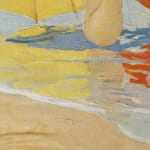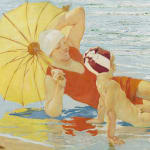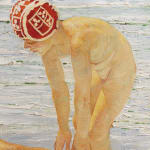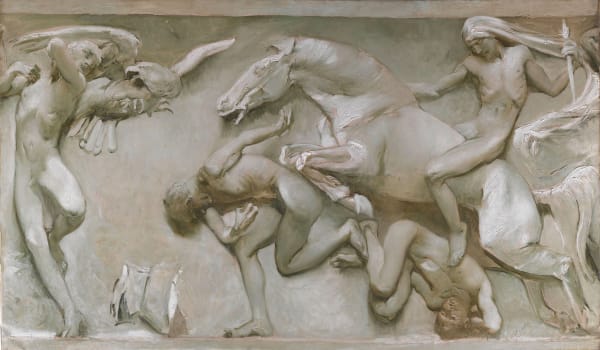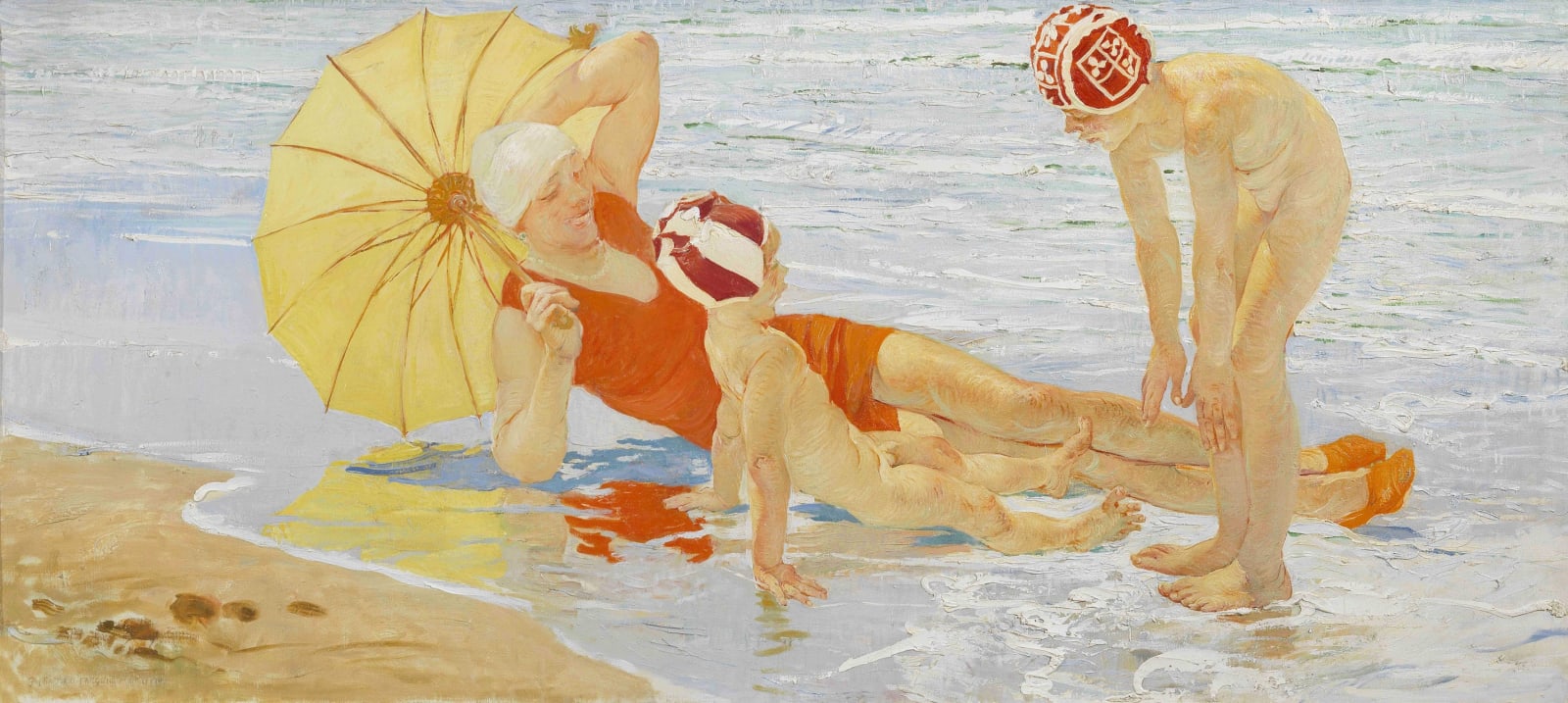
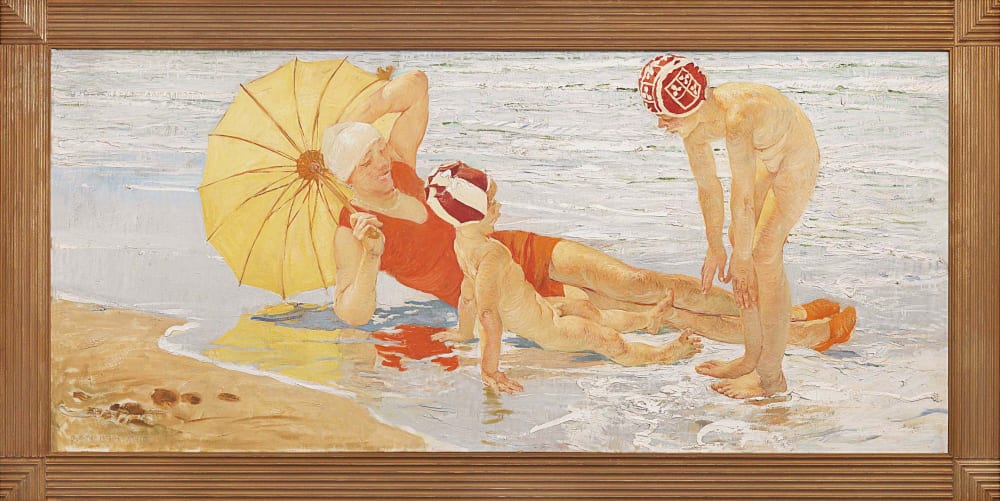


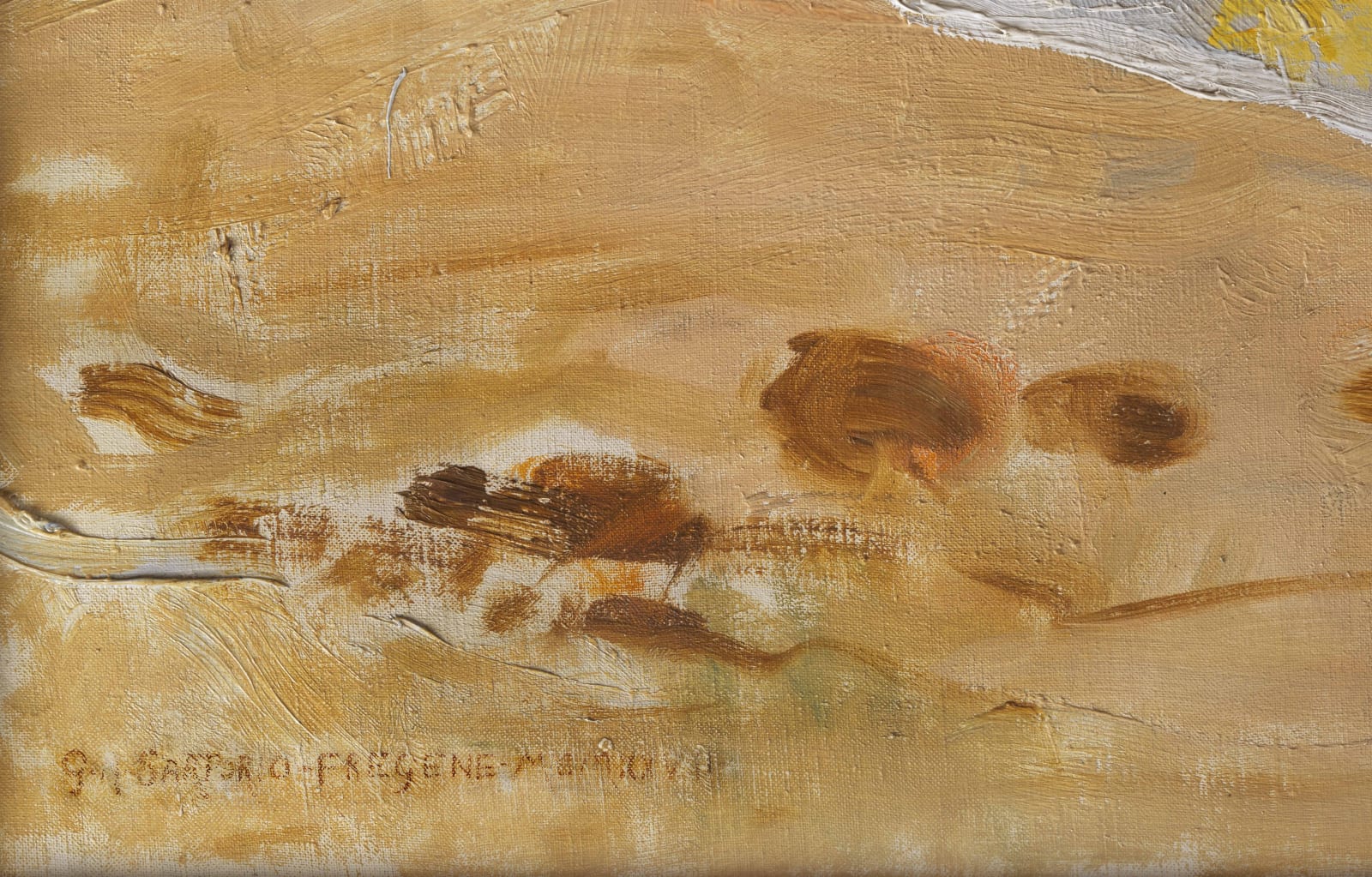


GIULIO ARISTIDE SARTORIO ROME, 1860 -1932
SOLD
Further images
Provenance
Marga Sevilla Sartorio collection, Rome; private collection, New York
Exhibitions
Milan, Galleria Pesaro January 1929;
Rome,I Quadriennale d’Arte Nazionale, 1931
Milan, Finarte casa d’aste 15 February – 3 March 1969
Rome, Galleria dell'Emporio Floreale, November 1973
Carrara, Palazzo Cucchiari, July - October 2022
Literature
Mostra personale del pittore Giulio Aristide Sartorio, Milan, Galleria Pesaro, January 1929, Bestetti e Tumminelli editore, Milan-Rome 1929, n. 60;
G. A. Sartorio: mostra di cento dipinti, acquarelli, pastelli, disegni, exhibition catalogue, Finarte casa d'aste, Milan 15 February – 3 March 1969, Milan, 1969, n. 5, pl. 1;
Giulio Aristide Sartorio, exhibition catalogue, Galleria dell'Emporio Floreale, Rome 1973, s.p.
The tranquil family scene is set in Fregene, where the family would go early in the morning in the summer months, travelling from the "Horti Galatae", the villa that the painter had had built close to Porta Latina and had christened thus in honour of the film The Mystery of Galatea in which Marga was the leading lady, which he himself had written and directed in 1918 and on the set of which they first met.
The woman reclines languidly on the foreshore, offering the artist an excuse to dwell on the formation of her body's reflection on the water. The mother's intimate interaction with her children almost forms a closed triangle, upstream of which stands the artist, attentively and affectionately observing the scene.
After Sartorio married Marga, his family provided him with a pretext for painting a series of luminous portrayals of women with their children, a series of canvases known as the Fregene Cycle, that seem to point to the achievement of a belated family serenity. Their distinctive feature is the adoption of a light and luminous palette, marking a decisive turning point away from his dark wartime drawings.
The family album now in the Sartorio Archive contains numerous photographs that the artist took on the beach, some them belong to the same cycle as the painting under discussion here.
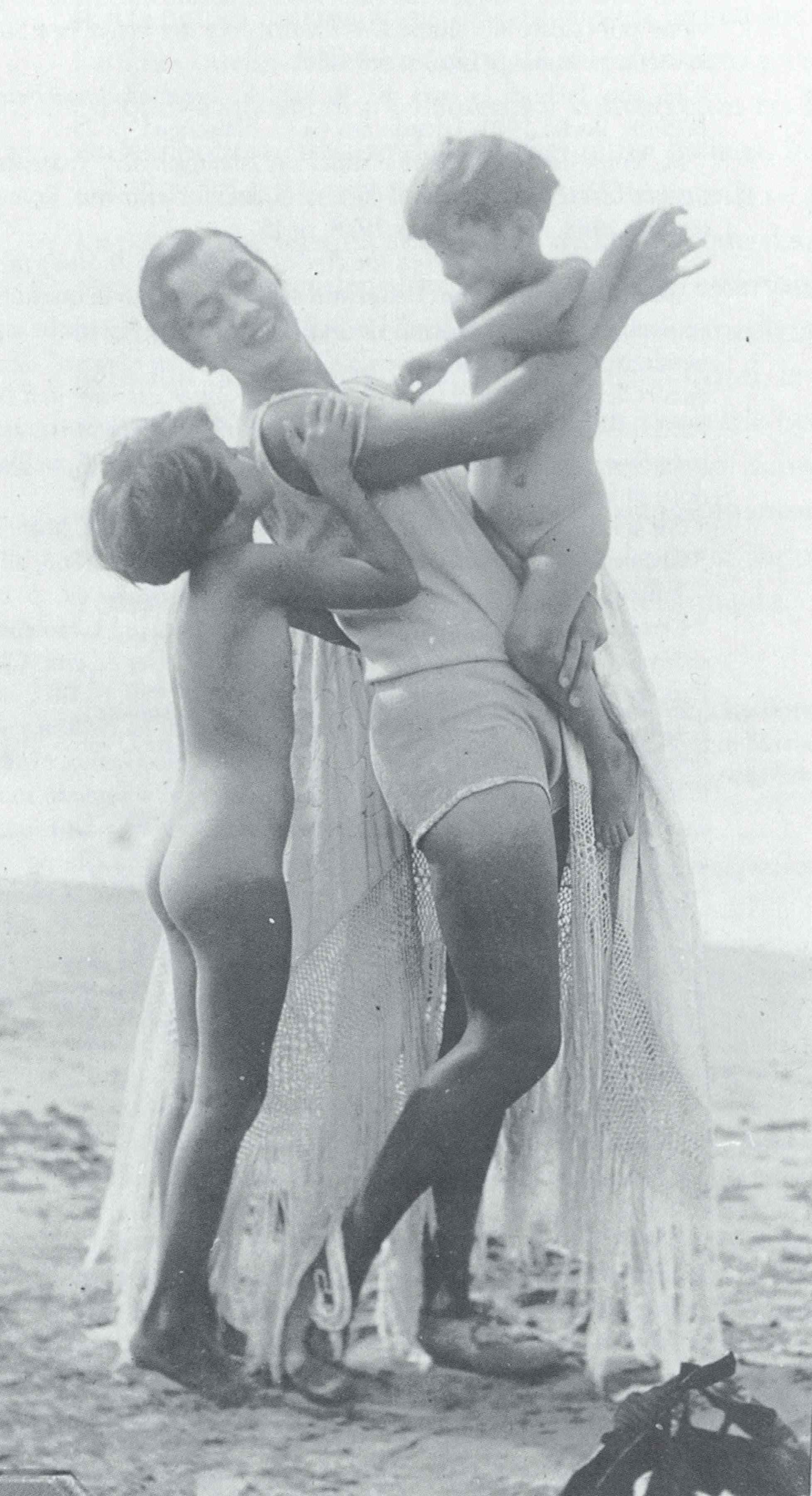
The paintings, like the photographs, all address the same theme (some of them, such as this one, were to be shown at the Galleria Pesaro in 1929). They are works in which the almost monochrome and occasionally magniloquent figures painted like statues in such decorative friezes as the frieze in the Latium Room at the Milan International in 1906 or the celebrated Parliament Frieze (1908–12), are but a distant memory. With their young bathers and their luminous seascapes that have an almost photographic feel to them, these pictures appear rather to offer a synthesis between the Sartorio of that era and the artist who was to produce paintings of the Roman countryside in a search for a deeper truth and a poetic vision of landscape.
The handling of light in the Fregene Cycle is different. Here light breaks impetuously into the picture, prompting the artist to play with the multiple transparencies of the air and the endless shades of blue on the sea, braving the challenging task of depicting the reflections of his figures' bodies on the water.
Sartorio adopts an almost musical approach to the paintings in this pleasing cycle, indeed so much so that in presenting his one-man show in Livorno in 1931, Bianca Flury Nencini described the subject matter as “living bodies in decorative symphonies fated to transcend the vagaries of time and fashion”1.
A Morning at the Seaside, in particular, should be associated with other large vertical paintings such as his Woman with a Child (also known as Maternity and Childhood, 1927, Rome, Galleria Nazionale d'Arte Moderna), with Stella Maris or with A Morning at Fregene, but above all with Joie de Vivre, in which the woman in the central panel holds a similar Japanese-style parasol and the little girl in the right-hand panel is portrayed in a remarkably similar position with only a handful of variants.
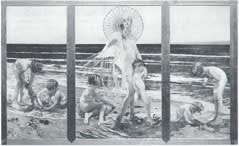
In fact the relationship is so close that the catalogue of a Finarte exhibition held in Milan in 1969 reproduced the painting under the title Yellow Parasol, correctly dated 1927 in the short entry but erroneously described as the central panel of the Joie de Vivre triptych2; and the two paintings do indeed present specific similarities, not only in their subject matter but also in the dimensions of the canvas, which is virtually identical in size to the two side panels even if the scene is set in a horizontal rather than a vertical position.
Some time later the picture was shown at the exhibition in the Galleria Emporio Floreale in Rome, being once again illustrated in the catalogue under the correct title of A Morning at the Seaside but this time around dated 1929, as indeed it is already dated in the catalogue for the Galleria Pesaro exhibition. The initial discrepancy in the dating of the work would appear to be due to a simple printer's error (a "typo"), especially if we consider that the date appears in the bottom left-hand corner of the picture and that the exhibition opened in January of that year – unquestionably too short a timeframe within which to produce a work of this importance and the exhibition catalogue.
This series of pictures tells of a happy time also recalled by Marga in the pages of “Capitolium” shortly after the artist's death. She writes: “… He bloomed again as his two girls started to blossom in the family that God had finally granted him; he felt that the horizon was opening up to new light and the rainbow of world peace found him once again with his creative strength undiminished. “My palette has lightened in my hands”, he would say with a smile. Hence the skies and the sea of Fregene where, undisturbed, in a solitude that seemingly dates back to the very origin of life, the painter and the small models that he created for himself sing the jocund paean between the two pearly heavens. The sea and sky of Fregene at 7 o'clock in the morning, in summer, two pearls that were solemnly and solely for him. This was the full joy of his art, this bare and laughing luminosity…”3.
In the catalogue of an exhibition held in Rome in 1980, Maurizio Fagiolo, writing with imaginative eloquence, describes A Morning at Fregene, a picture belonging to the same series as the painting under discussion here, as “a rustle of swathed beauties” in which “the themes associated with 'joie de vivre' blend transparent shawls with feeble waves”4.
Sartorio in this period shared a luminous palette with the coeval work of Ettore Tito in Italy. But also, indeed above all, the play of Mediterranean light and his lighthearted touch are reminiscent of certain works by Joaquin Sorolla y Bastida, an artist whom Sartorio had certainly met at more than one edition of the Venice Biennale in earlier years. Sorolla's crystal clear views of seascapes and related subjects had attracted widespread praise at the Venice Biennales of the period.
The suggestion that the two men rubbed shoulders is borne out in concrete terms by both the theme and the subject addressed. Such works as Joaquín Sorolla's Injured Foot and Sartorio's Little Injured Leg or, even more cogently, Just Emerging from the Sea (Madrid, Museo Sorolla) and Maternity and Childhood appear to be inspired by the same affectionate interest in reality fuelled by the family circle and bolstered by a passion for the sea, or rather by the revelation of its light, which in Sartorio's case also seems to point to a rediscovered inner serenity.
Sartorio certainly had the opportunity to familiarise with Sorolla's painting on more than one occasion at the earlier editions of the Venice Biennale, first in 1897 and then again two years later when Sorolla was a member of the sponsorship committee for his country along with José Benlliure, José Jimenez Aranda, Francisco Pradilla and José Villegas, while Sartorio for his part was showing over fifty works. Or when Sorolla showed Effect of Sun of the Sea and Fishing Net Menders5 at the 1903 Biennale and Sartorio was a member of the selection jury as well as the designer and decorator of the Latium Room. And finally, when Sartorio was working on the large Italian Parliament Frieze for the International Fine Arts Exhibition of 1911, Sorolla was holding a one-man show at which he showed his best-known works, including Bathing, Beach at Valencia and Bringing In the Net6.
Giovanna Caterina De Feo
Notes
1) Bianca Flury Nencini, Giulio Aristide Sartorio, in “Bollettino di Bottega d'Arte”, no. 4, March 1931, Belforte Editore, Livorno 1931, s.p
2) G. A. Sartorio: mostra di cento dipinti, acquarelli, pastelli, disegni, exhibition catalogue, Finarte casa d'aste, Milan 15 February – 3 March 1969, Milan, 1969, n. 5, pl. I
3) Marga Sartorio Sevilla, Aristide Sartorio l’uomo, in “Capitolium”, monthly review of the Governatorato, year VIII, no. 12, December, published by Bestetti e Tumminelli Milan – Rome 1932, pp. 699 – 611, esp. p. 602 – 603
4) Maurizio Fagiolo dell'Arco, “Guida Bifronte” Giulio Aristide Sartorio tra “critici d'arte, affaristi, preraffaelliti, donne senza sesso, uomini magniloquenti”, in Giulio Aristide Sartorio (1860 – 1932), catalogue of the exhibition curated by Angela Cipriani, Rome, Palazzo Carpegna 13 May – 20 June 1980, De Luca editore, Rome 1980, pp. 25 – 28, esp. p. 28
5) Quinta Esposizione Internazionale D’Arte della Città di Venezia, illustrated catalogue, Venice, Premiato Stabilimento di Carlo Ferrari 1903, p. 56
6) Esposizione Internazionale di Belle Arti, exhibition catalogue, Rome 1911, pp. 312 - 313
Join the mailing list
Subscribe to our newsletter to receive all the news about exhibitions, fairs and new acquisitions!


